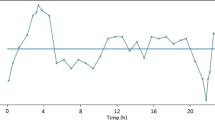Abstract
Intelligent alarm systems are needed for adequate bedside decision support in critical care. Clinical information systems acquire physiological variables online in short time intervals. To identify complications as well as therapeutic effects procedures for rapid classification of the current state of the patient have to be developed. Detection of characteristic patterns in the data can be accomplished by statistical time series analysis. In view of the high dimension of the data statistical methods for dimension reduction should be used in advance. We discuss the potential of statistical techniques for online monitoring.
Access this chapter
Tax calculation will be finalised at checkout
Purchases are for personal use only
Preview
Unable to display preview. Download preview PDF.
Similar content being viewed by others
References
Miller, G.: The Magical Number Seven, Plus or Minus Two: Some Limits to Our Capacity for Processing Information. Psychol. Rev. 63 (1956) 81–97
Jennings, D., Amabile, T., Ross, L.: Informal Covariation Asessments: Data-Based Versus Theory-Based Judgements. In: Kahnemann, D., Slovic, P., Tversky, A. (eds.): Judgment Under Uncertainty: Heuristics and Biases. Cambridge University Press, Cambridge (1982) 211–230
Imhoff, M.: One Year Experience with a UNIX-based Clinical Information System (CIS) on a SICU. In: Lenz, K., Metnitz, P.G.H. (eds.): Patient Data Management in Intensive Care, Springer-Verlag, Wien (1993) 107–114
O’Carrol, T.M.: Survey of Alarms in an Intensive Therapy Unit. Anaesthesia 41 (1986) 742–744
Miksch, S., Horn, W., Popow, C., Paky, F.: Utilizing Temporal Abstraction for Data Validation and Therapy Planning for Artificially Ventilated Newborne Infants. Art. Int. Med. 8 (1996) 543–576
Haimowitz, I.J., Kohane, I.S.: Managing Temporal Worlds for Medical and Trend Diagnosis. Art. Int. Med. 8 (1996) 299–321
Daumer, M.: Adaptive Drifterkennung und Intelligente Alarmsysteme. In: Biomedizinische Technik. Ergänzungsband. Schiele und Schoen (2000) to appear
Hill, D.W., Endresen, J.: Trend Recording and Forecasting in Intensive Care Therapy. Br. J. Clin. Equipment 1 (1978) 5–14
Gordon, K., Smith, A.S.M.: Modeling and Monitoring Biomedical Time Series. J. Am. Stat. Assoc. 85 (1990) 328–337
Hepworth, J.T., Hendrickson, S.G., Lopez, J.: Time Series Analysis of Physiological Response During ICU Visitation. West J. Nurs. Res. 16 (1994) 704–717
Imhoff, M., Bauer, M., Gather, U., Löhlein, D.: Time Series Analysis in Intensive Care Medicine. Applied Cardiopulmonary Pathophysiology 6 (1997) 263–281
Huber, P.J.: Massive Datasets Workshop: Four Years After. J. Comp. Graph. Stat. 8 (1999) 635–652
Smith, A.F.M., West, M.: Monitoring Renal Transplants: an Application of the Multiprocess Kalman Filter. Biometrics 39 (1983) 867–878
West, M., Harrison, J.: Bayesian Forecasting and Dynamic Models. Springer-Verlag, New York (1989)
Daumer, M., Falk, M.: On-line Change-Point Detection for State Space Models Using Multi-process Kalman Filters. In: O’Leary, D. (ed.): Proceedings of the International Linear Algebra Society Symposium on Fast Algorithms for Control, Signals and Image Processing. Elsevier, Amsterdam (1998) 125–135
Cook, R.D.: Detection of Influential Observations in Linear Regression. Technometrics 19 (1977) 15–18
Peña, D.: Influential Observations in Time Series. J. Business & Economic Statistics 8 (1990) 235–241
De Jong, P., Penzer, J.: Diagnosing Shocks in Time Series. J. Americ. Statist. Assoc. 93 (1998) 796–806
Gather, U., Fried, R., Imhoff, M.: Online Classification of States in Intensive Care. Technical Report 15/2000, SFB 475, University of Dortmund, 44221 Dortmund, Germany.
Box, G.E.P., Jenkins, G.M., Reinsel, G.C.: Time Series Analysis. Forecasting and Control. Third Edition. Prentice Hall, Englewood Cliffs (1994)
Imhoff, M., Bauer, M., Gather, U., Fried, R.: Pattern Detection in Intensive Care Monitoring Time Series: Influence of the Model Order. Preprint, SFB 475, University of Dortmund, 44221 Dortmund, Germany
De Gooijer, J.G., Abraham, B., Gould, A., Robinson, L.: Methods for Determining the Order of an Autoregressive-moving Average Process: a Survey. Int. Stat. Rev. 55 (1985) 301–329
Imhoff, M., Bauer, M.: Time Series Analysis in Critical Care Monitoring. New Horizons 4 (1996) 519–531
Lambert, C.R., Raymenants, E., Pepine, C.J.: Time-Series Analysis of Long-Term Ambulatory Myocardial Ischemia: Effects of Beta-Adrenergic and Calcium Channel Blockade. Am. Heart J. 129 (1995) 677–684
Bauer, M., Gather, U., Imhoff, M.: The Identification of Multiple Outliers in Online Monitoring Data. Technical Report 29/1999, SFB 475, University of Dortmund, 44221 Dortmund, Germany
Bauer, M., Gather, U., Imhoff, M.: Analysis of High Dimensional Data from Intensive Care Medicine. In: Payne, R., Green, P. (eds.): Proceedings in Computational Statistics. Springer-Verlag, Berlin (1999) 185–190
Cox, D.R., Wermuth, N.: Multivariate Dependencies. Chapman & Hall, London (1996)
Dahlhaus, R.: Graphical Interaction Models for Multivariate Time Series. Metrika (2000) to appear
Gather, U., Imhoff, M., Fried, R.: Graphical Models for Multivariate Time Series from Intensive Care Monitoring. Preprint, SFB 475, University of Dortmund, 44221 Dortmund, Germany
Li, K.C.: Sliced Inverse Regression for Dimension Reduction. J. Americ. Statist. Asoc. 86 (1991) 316–342
Morik, K., Imhoff, M., Brockhausen, P., Joachims, T., Gather, U.: Knowledge Discovery and Knowledge Validation in Intensive Care. Art. Int. Med. (2000) to appear
Author information
Authors and Affiliations
Editor information
Editors and Affiliations
Rights and permissions
Copyright information
© 2000 Springer-Verlag Berlin Heidelberg
About this paper
Cite this paper
Fried, R., Gather, U., Imhoff, M., Bauer, M. (2000). Some Statistical Methods in Intensive Care Online Monitoring — A Review. In: Brause, R.W., Hanisch, E. (eds) Medical Data Analysis. ISMDA 2000. Lecture Notes in Computer Science, vol 1933. Springer, Berlin, Heidelberg. https://doi.org/10.1007/3-540-39949-6_11
Download citation
DOI: https://doi.org/10.1007/3-540-39949-6_11
Published:
Publisher Name: Springer, Berlin, Heidelberg
Print ISBN: 978-3-540-41089-8
Online ISBN: 978-3-540-39949-0
eBook Packages: Springer Book Archive




